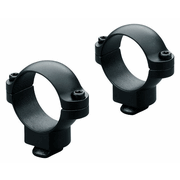A customer asked a question on the Riflescope Forum the other day I thought would be useful for this blog. Here is the question:
Does anyone know the significant differences between getting a 1 piece or a 2 piece? Also what if any differences (pros/cons, purpose) are between a Dual dovetail design, “Standard” design or a $100+ Mark 4 Base and Rings? I am planning to get a Remington 700 LTR with a Leupold Mark4 4.5-14x40mm, what are my best options for leupold rings/bases? Thanks in advance!
Here’s what I answered:
Significant differences are none. Minor differences are that two piece bases offer more eye relief options with sometimes reversible front and/or rear bases, use two screws on each base, are lighter, cleaner looking, and offer increased loading room for top loading guns. One piece bases generally use three screws, offer insignificantly more receiver rigidity, are a bit heavier, and decrease loading room for top loaders. Standard bases have a front ring which turns into the base 90 degrees. The rear base sits between two opposing screws and is held in place by tightening these screws into circular grooves on the ring. These screws can be loosened and tightened to move the base perpendicular to the receiver, effecting a way to adjust windage on your mounts instead of your scope. Dual dovetails have the rear ring turning in 90 degrees just like the front ring. This does not allow for any windage movement in the base. Rarely will this be a cause for concern, as it is extremely uncommon for the base holes to be off center enough to cause a problem that a bit of windage adjustment in the scope can’t fix. A scope does not have to be mounted in perfect center of its adjustment range. I use two piece dual dovetails on most of my guns becase they look clean and have two less parts (the opposing screws on the rear base) to loosen or have a problem with, which I have seen many times. To be certain, though, you can easily mark your scope by installing it in rings that are not lined up perfectly. No rings will be, and I recommend lapping rings every time. Weaver style and Picatinny bases and rings can be quite a bit stronger overall depending on the manufacturer used because of the amount of bearing surface. The recoil lugs can be almost 7/8″ wide on these systems. By the way, Weaver rings use a recoil slot in the base that is about .180″, and Picatinnys use a slot about .206″. This varies slightly by manufacturer. Some manufacturers call their Picatinny Weaver and some call their Weaver Picatinny. Picatinny is a U.S. arsenal in New Jersey where in 1913 they standardized the dimensions of the base. That’s why a Picatinny base is also called a 1913. Not truly a Weaver, although a Weaver ring will fit on a Picatinny base but not vice versa. Not all the strength you can get is always needed or wanted. The lug nuts on my truck are not an inch in diameter. Dual dovetails suit me fine. I’m not a soldier and people aren’t shooting at me and I’m not dragging and bouncing my gun around for weeks on end. Don’t get me wrong, I’ve hunted hard my whole life and I know the abuse guns take in the field and getting there. But enough is enough. It can get to the point of diminishing returns. You have a hell of a gun and one of my favorites, and even though I have been advocating dual dovetails, your gun and scope combination was kind of made for Mark 4 rings and bases. I would use Mark 4 #61983 bases and Mark 4 rings #61049 (steel) rings or Mark 4 aluminum rings (save a bit of weight and plenty strong) #57398. If money is no object use Nightforce base (20 MOA built-in) #NF700SA120 and Ultralight Titanium alloy rings #NF885UL. Nothing is better unless you want to enlarge your mounting screws to 8-40.
And by the way, Happy Thanksgiving. We have a lot to be thankful for every day.

 Follow
Follow
One Response to >Different Base Types